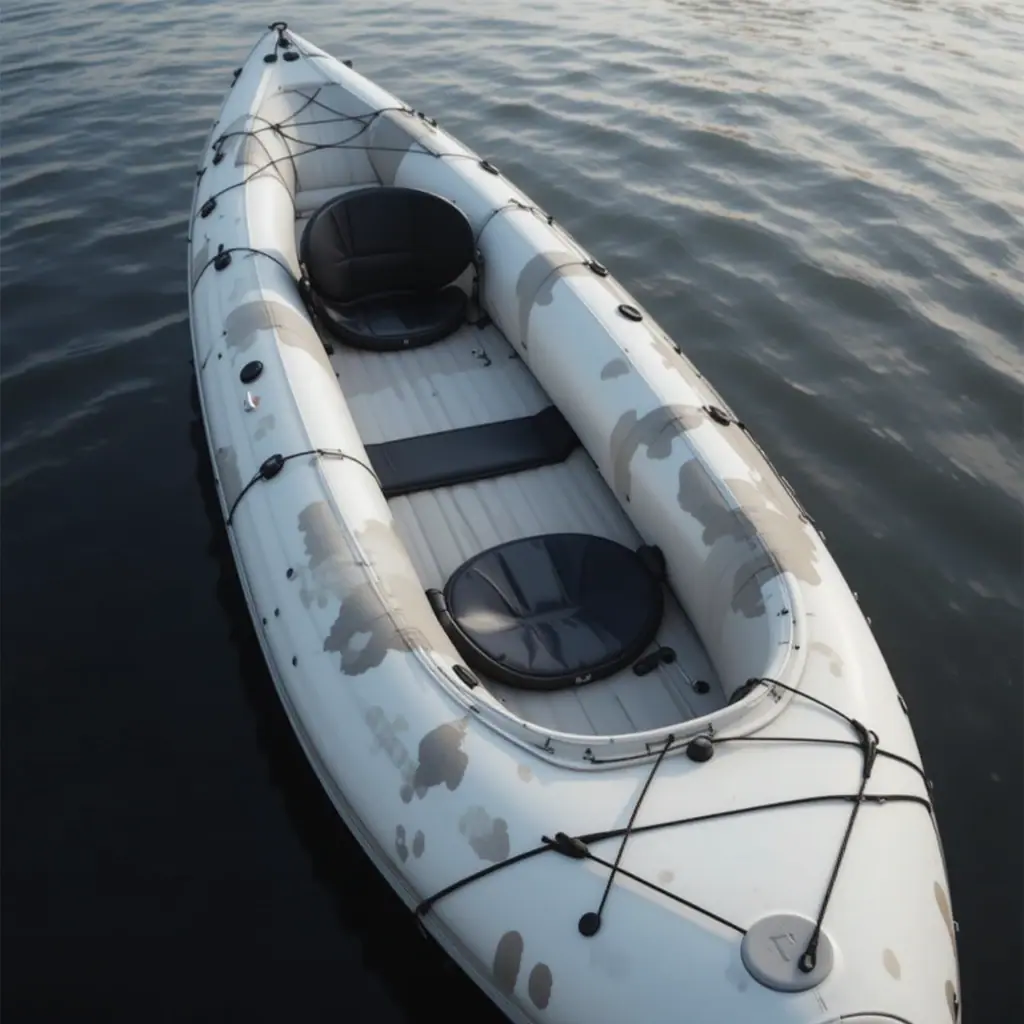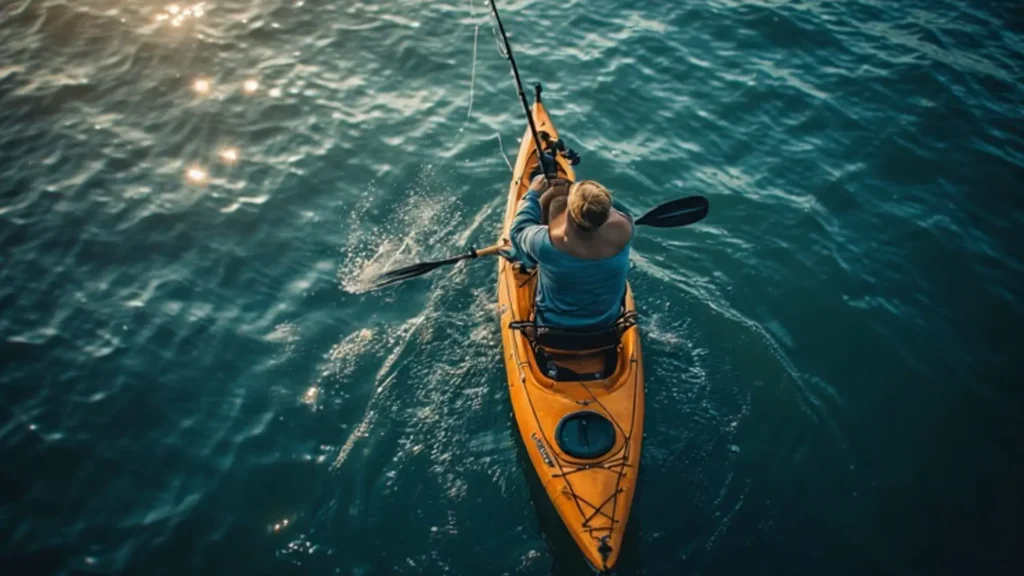Inflatable kayaks have combined portability, versatility, and performance. Inflatable kayaks are lightweight and easy to transport. These kayaks are engineered with advanced materials and innovative designs. Understanding the key design features of inflatable kayaks is essential for choosing the right model for your needs.
Design Features of Inflatable Kayaks
Hull Material
PVC is one of the most commonly used materials. It is durable, lightweight and affordable. Often reinforced with polyester or nylon, PVC provides a sturdy surface that resists punctures and abrasions. It is a budget-friendly choice for inflatable kayaks. However, it damages over time due to UV rays.
Hypalon solves the problem and resists UV rays, abrasions, and harsh weather conditions. Its superior longevity makes it an excellent choice for adventurers tackling challenging environments. Hypalon is expensive than PVC.
Nitrylon presents a sustainable alternative. This eco-friendly material is highly resistant to punctures. It is ideal for winter kayaking. Nitrylon enhances durability and reduces environmental impact.
Inflation Chambers
The design and construction of inflation chambers directly impacts safety, stability, and performance. Multiple air chambers are a key safety feature. It ensures that if one chamber is punctured or damaged, the kayak remains buoyant and functional. The chambers are usually positioned in separate sections, such as the sides, floor, and bow.
Some inflatable kayaks come with high-pressure floor with drop-stitch technology. This advanced technique involves interwoven threads connecting the top and bottom layers of the chamber. High-pressure floor significantly improves the kayak’s stability, tracking, and overall handling, making them ideal for activities like touring, fishing, and whitewater paddling. These chamber designs ensure that inflatable kayaks are both safe and performance-oriented.
Shape and Dimensions of Inflatable Kayaks
The hull shape is a primary determinant of how the kayak handles in various environments. A flat-bottom hull offers exceptional stability. It is an ideal choice for beginners. Its wide, steady base ensures a balanced ride.
V-shaped hull is a preferred design for experienced kayakers. This streamlined shape cuts through water efficiently. On the other hand, a rockered hull, with its curved ends, is designed for agility and maneuverability. It is a smart choice for its ability to quick directional changes and precise control.
The length of an inflatable kayak also plays a significant role in its performance. Shorter kayaks, typically between 8 and 10 feet, are highly maneuverable and better suited for recreational use. Conversely, longer kayaks, ranging from 12 to 16 feet, offer improved tracking and speed. These kayaks are ideal for touring, ocean paddling, and carrying additional gear for extended trips.
Lastly, the width of the kayak impacts its stability and speed. Wider inflatable kayaks provide a stable platform. These kayaks are preferable for beginners and anglers. But the wider space reduces speed and performance.
Seating System
Adjustable seats are designed to offer customizable support for paddlers of varying heights and preferences. These seats ensure proper posture and reduce fatigue.
Removable seats add another layer of flexibility. Removable seats allow you to paddle alone or with a partner. This feature is particularly useful for those who want a kayak that can accommodate different group sizes and activities.
To maximize comfort, many inflatable kayaks are equipped with padded seats. These seats offer cushioning that absorbs the impact of prolonged paddling. Inflatable seats, in particular, are lightweight and easy to adjust, allowing paddlers to fine-tune firmness according to their preferences.
Valves
The valves are important for the ease of inflation and deflation. Boston valves are among the most commonly used and widely recognized for their simplicity and reliability. They are easy to use with most pumps. The design enables quick and efficient inflation, as well as fast deflation for storage. These valves are budget-friendly.
For higher-end inflatable kayaks, Halkey-Roberts valves are the preferred choice. Known for their high quality and durability, these valves are built to withstand the wear and tear of regular use in demanding conditions. The design of Halkey-Roberts valves ensures that air stays sealed in the kayak in all conditions. These valves are favored for their enhanced performance, leak resistance, and long-term reliability.
Pressure relief valves are another important safety feature. These valves automatically release air if the internal pressure becomes too high. Pressure relief valves ensure optimal performance while safeguarding against the risk of damage from overinflation. Together, these valve types contribute to a seamless, hassle-free paddling experience.

Self-Bailing System
The self-bailing system ensures paddlers stay dry in challenging conditions. The two primary types of self-bailing systems are open drains and sealable drains, each designed to handle different water conditions.
Open drains allow the water to flow out quickly. It prevents the kayak from filling up and maintains buoyancy and stability. Open drains are typically positioned at the kayak’s floor or sides and work effectively in fast-moving water.
Sealable drains, on the other hand, provide versatility for paddlers who want to choose between a dry ride or a self-bailing setup. These drains can be closed to keep water out and maintain a dry, comfortable interior when paddling on calm waters. However, when venturing into rougher conditions, the drains can be opened to allow water to exit, providing a self-bailing function.
Deck Types
Inflatable kayaks come with different deck configurations – open decks, closed decks, and removable deck covers.
Open decks provide freedom and space for movement. The open design allows for easy entry and exit. Open decks promote better ventilation to keep you cool during hot weather. But this isn’t a good option in colder condition. They expose you to splashes and waves.
Closed decks keep the cockpit sealed, which helps maintain heat and prevent water from splashing into the kayak. However, they can limit the ease of entry and exit compared to open decks.
Removable deck covers offer the ultimate flexibility. It allows paddlers to switch between open and closed deck configurations depending on the conditions. When using the kayak in calm waters, you can keep the deck open for maximum ventilation. However, for colder or rougher conditions, you can attach the cover to create a more enclosed, protected environment.
Skegs
The primary function of a skeg is to reduce lateral drift caused by wind, current, and waves. Skegs are particularly useful when navigating long distances on calm waters. Some inflatable kayaks offer removable skegs. It provides flexibility by allowing paddlers to adjust the kayak’s setup according to the conditions. You can remove the skeg entirely for shallow-water navigation.
Accessories and Features
Inflatable kayaks come with a range of accessories and features. These additions are designed to make kayaking enjoyable, practical, and adaptable to different activities and environments.
Carry handles are one of the most basic features found on most inflatable kayaks. Positioned at the bow, stern, and often along the sides, carry handles make it easy to transport the kayak both on land and into the water. These handles are especially helpful for solo paddlers who need assistance with lifting and carrying the kayak. Their placement ensures that the kayak can be handled from multiple angles for a secure grip.
D-rings and tie-downs allow paddlers to securely fasten gear such as coolers, dry bags, and camping equipment. D-rings provides easy points for securing belongings. Tie-downs can be used to prevent gear from shifting during a trip.
Bungee storage areas are commonly found on the deck of inflatable kayaks. These elastic straps are perfect for storing small items that need quick access. The bungee system provides a convenient and accessible way to keep frequently used items secure.
Rod holders are an indispensable feature for anglers. These are often found on fishing-specific inflatable kayaks. Rod holders are typically adjustable and can be positioned for optimal accessibility and convenience.
Spray skirts are valuable accessories. These waterproof covers attach to the kayak’s cockpit, and keeps water from splashing into the kayak. Spray skirts are especially beneficial for paddling in choppy or turbulent conditions.
Performance Enhancements
Performance enhancements are especially valuable for paddlers who engage in specific activities and seek to optimize their kayaking experience across varying water conditions.
Drop-stitch floors are one of the most innovative performance enhancements found in inflatable kayaks. This technology involves thousands of tiny threads connecting the top and bottom layers of the kayak’s floor. It allows the kayak to be inflated to higher pressures. The rigidity of a drop-stitch floor mimics the performance of a hard-shell kayak.
Wide beams create a broader base. This is especially beneficial for anglers who need a secure platform to cast and reel in fish without the kayak tipping over. For novice paddlers, a wider beam makes the kayak forgiving.
Streamlined designs reduce water resistance. It helps the kayak to cut through the water with minimal drag. This makes it an excellent choice for long-distance touring, expeditions, and open-water kayaking. The added speed also enhances maneuverability and responsiveness.
Safety Features
Reflective strips are an important safety feature that increases the kayak’s visibility in low-light and nighttime conditions. These high-visibility strips are usually placed along the hull or deck of the kayak.
Grab lines, or safety ropes, are installed along the perimeter of the kayak and serve as essential tools for re-entry in case you fall out or capsizeGrab lines are typically placed strategically along the bow, stern, and sides.
Air pressure indicators help you monitor the internal pressure of the kayak’s chambers, ensuring that they are inflated to the correct levels. Overinflating or underinflating the kayak can affect its stability, performance, and safety. An air pressure indicator gives you a clear and easy way to confirm that the kayak is correctly inflated before you set out.
Storage and Portability
Foldable design is a core feature of inflatable kayaks. It allows them to be packed down into a compact, portable form when not in use. The kayak can be deflated and folded. This feature is perfect for limited storage space at home and on vehicle. When deflated, the kayak becomes lightweight and easy to handle. It can be stored in a closet, car trunk, and even checked as luggage for air travel. The foldable design makes it possible for paddlers to bring their kayaks to locations where traditional hard-shell kayaks would be impractical.
Compact storage bags can pack up and store the kayak with ease. The compact size of these bags makes them ideal for carrying the inflatable kayak on vacation, and to remote locations.
In conclusion, inflatable kayaks are a remarkable innovation that caters to paddlers of all skill levels and interests. Their lightweight, compact design offers unmatched convenience. Understanding their key design features allows you to select the perfect kayak to suit your needs, ensuring countless enjoyable experiences on the water.




